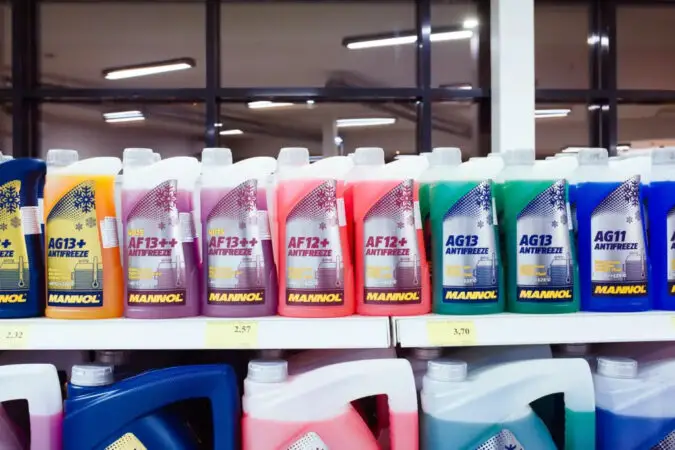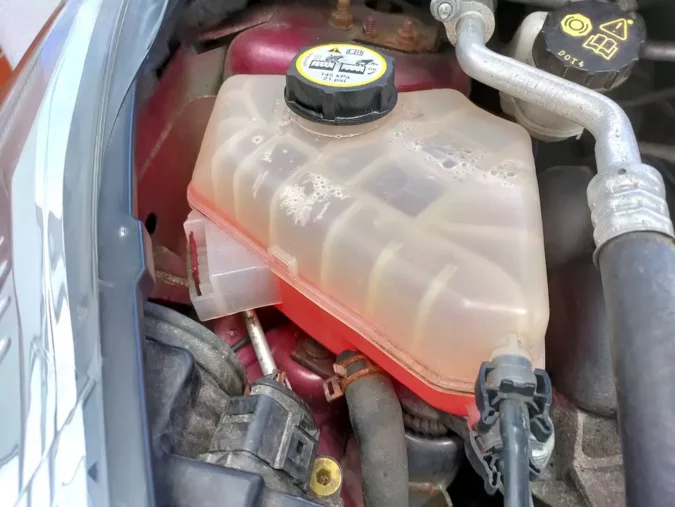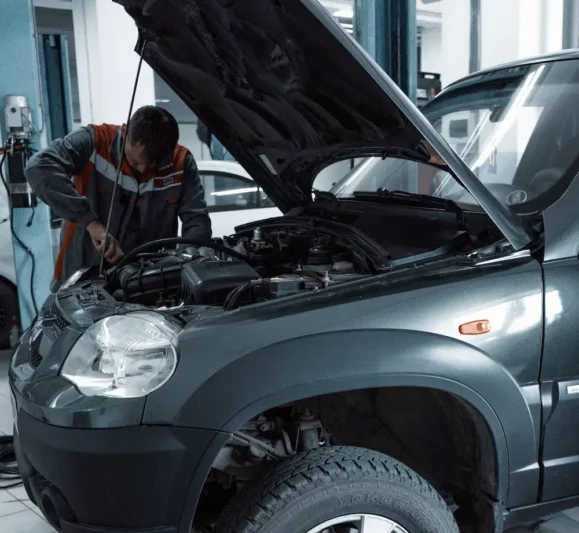From green antifreeze to blue antifreeze, which one is actually right for you? Does the color even matter? Can you mix the colors? What’s the difference between antifreeze and coolant? Do you actually need them for your car?
If you’ve been wondering about green antifreeze or coolant in general, you’ve come to the right place dear readers. This post will discuss everything there is to know about antifreeze. And by the end, you’ll be an antifreeze expert and your friends and families will be impressed with your newfound knowledge. Or at least, you can bore them with it.
In any case, here’s all you need to know about green antifreeze and everything else surrounding the topic:
Antifreeze VS Coolant
Before we get into green antifreeze and the other colors (such as yellow antifreeze), let us explain what antifreeze is first. Of course, feel free to skip this section if you already understand this topic.
Anyway, antifreeze is an additive that does precisely what the name suggests: it prevents freezing. Well, sort of. Antifreeze doesn’t actually prevent freezing, but it lowers the freezing temperature of a fluid so that it’s less likely to freeze.
Antifreeze is made from either ethylene glycol or propylene glycol, but both serve the same purpose. Now, the term antifreeze and coolant are often used interchangeably, and we can’t talk about one without mentioning the other. So, is there a difference between the two?
Technically, there’s a difference. Antifreeze is essentially its concentrated form. Meanwhile, coolant is antifreeze that’s been diluted with water. Add water to antifreeze and voila! You have coolant. If you need further guidance, we have a guide on how to put coolant in a car. Manufacturers sell both concentrate and diluted antifreeze for customers. To understand more, continue reading:
Antifreeze Concentrate
A term you may often see or hear is “antifreeze concentrate”, and is this different from regular antifreeze? Well, antifreeze comes in two forms: concentrate and premixed.
As the name suggests, a concentrate is still pure antifreeze. And you’ll need to mix them with water before putting them in your car’s cooling system. To learn more, check out our insight into whether can you put water in the coolant tank. This is because pure antifreeze has less heat capacity, reducing its heat absorption capabilities by about 35 percent, so it’s not ideal for the car.
Manufacturers will typically recommend a 50:50 mix of antifreeze concentrate and water before you put it in the car. But check the instructions on the packaging just to be sure. Also, make sure to always use distilled water. Mineral or tap water can damage your car’s cooling system.
Meanwhile, premixed antifreeze comes, well, premixed with water. As mentioned, this is now technically a coolant. In any case, you can directly pour them into your car’s cooling system and you’re good to go. This makes it the more convenient solution (such as G12 coolant, among others), and we’re not entirely sure why manufacturers still offer both.
It’s important you know this distinction before buying so that you can get the right product for your needs. But what does coolant/antifreeze actually do in your car? Well, I’m glad you asked. Or at least, I assumed you asked. Here’s what coolant is for:
Green Antifreeze: How It Works
Antifreeze, sometimes referred to as coolant, is an essential part of your car’s cooling system. If you already understand a car’s cooling system, feel free to skip this section. If else, here’s a quick lesson on a car’s cooling system:
Your car’s cooling system essentially works by circulating coolant/antifreeze through passages inside the engine. As the coolant passes through, it absorbs the heat of the engine. The system then sends the coolant to the car’s radiator, where it will disperse the heat from the coolant.
The radiator has tons of fins to help dissipate the heat. Additionally, there’s a radiator fan or two that also help to disperse the heat. Afterward, the car’s water pump will circulate the now-cooled coolant back into the engine to repeat the process during the engine’s operation.
Of course, there are a few more components that help make the entire system work. But that’s the gist of how the system works. You can learn more in the video above.
Purpose Of Antifreeze
As mentioned, the purpose of antifreeze is to lower the freezing temperature of a fluid. In the case of cars, antifreeze prevents the coolant from freezing, and keeps the cooling system—and the engine—running smoothly and safely even in the extreme cold.
Water will freeze at 32°F or 0°C. But by using antifreeze, the freezing point will drop to as low as -37°F, allowing your car to work smoothly even in extreme winter conditions. Additionally, it also raises the boiling point to 223°F, making it more effective at cooling your engine.
Your car’s cooling system won’t be able to circulate coolant if it’s frozen. This can result in overheating and possibly severe engine damage that may require rebuilding an engine. So, that’s why manufacturers add antifreeze to coolants.
Green Antifreeze And Other Colors
As you probably know, antifreeze or coolant comes in several different colors. While the coolant is usually based on ethylene glycol, there are different additives and manufacturing processes. And the coolant color is how we differentiate them, to make sure that it meets the car’s needs. Here are the different types of antifreeze (and understanding what coolant does my car need):
Green Antifreeze
Green antifreeze or coolant is one of the early coolants and uses IAT or Inorganic Additive Technology. The green antifreeze uses silicates as an inhibitor, and you’ll find most older cars using green antifreeze.
IAT or green antifreeze is still commonly used today, mostly in Japanese cars. While they do the job just fine, they typically need a coolant change every 24,000 miles. But this may differ depending on your car’s make and model.
Orange Antifreeze
The next evolution of green antifreeze was the OAT-type coolant or Organic Acid Technology, which usually comes in orange. This uses organic acids as the base for the coolant, and you’ll find many General Motors, Saab, and VW cars using this type.
Neither green antifreeze nor orange antifreeze is better at keeping the engine cool, but orange antifreeze may go up to 60,000 miles without a change.
Red And Turquoise Antifreeze
HOAT or Hybrid Organic Acid Type is the next type of coolant, which uses a mix of silicates and organic acids. They come in the color red, and manufacturers often brand them as Extended Life Coolant as they can go up to 100,000 miles or five years before needing a change.
HOAT-based antifreeze is also available in the color turquoise, and you’ll find most BMW and MINI cars using this color. We’re not exactly sure what’s the difference between red and turquoise, but it’s usually the additives that the manufacturers use.
Blue And Pink Antifreeze
Finally, we have the P-HOAT-based antifreeze, made from phosphates and organic acids. This comes in either blue or pink, depending on the manufacturer. Carmakers that use this blue antifreeze include Toyota, Nissan, and Hyundai amongst others.
Again, the difference between blue and pink antifreeze isn’t clear, but our best guess is that it has something to do with additives. It all depends on the manufacturer.
But with all these different types, which one is right for your car? Should you use green antifreeze for your car? Well, that segues us nicely into our next section:
Green Antifreeze: Is It Right For You?
So, is green antifreeze the right color for your car’s cooling system? The answer lies in your owner’s manual. Every owner’s manual will have a section about the cooling system, and you’ll find the recommended coolant color for your car in there.
Always use the coolant color recommended by your owner’s manual. Using a different color can damage the car’s cooling system, and will result in an expensive repair job that can cost up to thousands of dollars.
If you’ve lost your manual, you can search for it online. Make sure to input the right make, model, year, and engine or car trim when searching. Some cars come in different trims with different engines, and each trim may require a different coolant.
Green Antifreeze And How To Maintain Your Cooling System
Now you can find out whether green antifreeze is the right one for your car or not. But your car’s cooling system is complex and will require maintenance to keep running safely and protect your engine.
Needless to say, a bad cooling system can cause severe engine damage that’s costly to repair. And it’s always better to prevent than to fix. So, here are our tips on how to maintain your car’s cooling system:
Green Antifreeze And Maintenance #1: Tighten The Radiator Cap
Quick engineering lesson: your car’s cooling system is a high-pressure system during operation, and it needs to maintain the correct pressure. Otherwise, the system won’t function properly or even burst, ultimately damaging the system and your engine.
To maintain this pressure, your car uses a pressurized cap, which is usually the radiator cap. However, some cars may not have a radiator cap at all, and the pressurized cap is on the coolant reservoir tank (not to be confused with the coolant overflow tank).
In any case, ensure the cap is in good condition and that you tighten it properly. You should replace it if the cap seems to doesn’t tighten properly, or if you see antifreeze leaking out from the cap when the engine is running.
You needn’t worry if you have a new car, as most radiator caps will last for at least 10 years, often much longer than that. They’re usually no more than $30 to purchase, just make sure you buy the correct one for your car’s specific make and model. You can learn more in our guide to the symptoms of a bad radiator cap.
Green Antifreeze And Maintenance #2: Clean The Radiator
The fins—or the radiator core—in your car’s radiator help to dissipate heat from the coolant. They get dirty over time, so cleaning them can help maintain optimum cooling performance and extend the radiator’s lifespan. Additionally, it’s a good chance to check their condition.
Cleaning the radiator core itself is easy: spray it with water, use a coil cleaner (somewhat optional) rinse it, and dry it off. Make sure to remove any large debris beforehand, and don’t use a pressure washer to prevent damage to the fins.
The hard part is removing the bumper. Most cars will require you to remove the bumper to gain access to the radiator, and this can be a tricky process for those uncomfortable with removing body panels. Additionally, some may also require you to remove the radiator fan as well.
Cleaning the radiator fins is somewhat optional; great if you do it (carmakers recommend it once a year), but should be fine even if you don’t. It’s a go-the-extra-mile sort of maintenance.
While we’re talking about cleaning fins, we do recommend cleaning your car’s AC condenser. The condenser looks like a small radiator and is a crucial part of your car’s AC system. Cleaning the condenser will help keep your AC cool and potentially increase your AC system’s lifespan.
Green Antifreeze And Maintenance #3: Flush The Cooling System
Disclaimer: I had a bad experience with flushing my car’s cooling system a couple of years ago. My car had around 150,000 miles on the clock, and the dealer recommended a radiator flush. I agreed to their recommendation and went ahead with the job.
Afterward, leaks started occurring with the cooling system; first was with one of the lines, and then another coolant leak occurred at the water pump (which can be noted by an empty coolant reservoir). And because of this, I am always somewhat hesitant to recommend a cooling system flush.
However, my experience seems to be an isolated case of a bad cooling system flush. It seems that the dealer didn’t properly clean the cooling system, which resulted in a lot of leftover corrosion and rust circulating the system, damaging the system and resulting in leaks.
So, make sure to do a cooling system flush at a good dealer or repair shop. Search for reviews, and ask for recommendations from friends and families. Or as they say: if you want a job done properly, do it yourself. This should save you a lot on the coolant flush cost.
Doing a proper cooling system flush can take the better part of the day. But you’ll have full control over the process, and you can do it properly. The video above by ChrisFix is a great guide and will help you do a cooling system flush properly.
Green Antifreeze And Maintenance #4: Check For Leaks
Cooling system leaks can happen externally or internally. An external leak will typically be visible, although smaller leaks may still be hard to spot (so much so, that you have to diagnose a car that’s losing coolant but there’s no visible leak). Meanwhile, an internal leak usually happens at the head gasket.
The head gasket—among its other purposes—prevents coolant from leaking into the engine cylinder. But a blown head gasket can cause coolant to leak into the cylinders, causing coolant or antifreeze to burn with the fuel and air mixture. So, be attentive to the symptoms of a low coolant level.
Both external and internal leaks will cause your car to lose coolant and will lead to an overheating engine, due to the low coolant levels. An internal leak is particularly bad as it can damage the engine internals. But in both cases, you’ll want to address them immediately.
Check your coolant reservoir tank at least twice a year. If you’re constantly losing coolant, then inspect the engine bay and the underside of your car for a leak. If you see green antifreeze—or whatever color your car uses—in the engine bay or underneath the car, try to source the leak.
Meanwhile, an internal leak will usually cause white smoke to come out of the exhaust pipes. You can learn more about internal leaks in this guide to a blown head gasket, as well as, what causes a coolant leak.
Green Antifreeze And Maintenance #5: Use The Right Antifreeze Or Coolant
Of course, the easiest and most important step is to use the correct antifreeze for your car. Whether it’s green antifreeze, blue antifreeze, or whatever color your owner’s manual recommends, always stick with the recommendation and DO NOT mix coolant colors.
Mixing the colors can result in a sludgy substance that will block the system. This will lead to the engine overheating (like when your car overheat when AC is on), and costly engine damage and repairs that your bank account won’t appreciate. For a more detailed look into this issue, check out our write-up on whether can you mix coolant colors, as well as whether can you mix antifreeze.
Additionally, fill the system with the appropriate amount of antifreeze. Locate your car’s coolant reservoir tank, and there’s a minimum and maximum marker. Always fill it in between those markers. Overfilling and underfilling can result in damage to the system, and ultimately the engine. You can learn more in our explainer on what happens if you overfill with coolant.
Another tip: don’t use old antifreeze that’s been stored in an open container. They easily attract dust, which could damage the cooling system. Always use brand-new coolant or coolant that’s been stored in a sealed container.
Green Antifreeze: FAQs
Got more questions about green antifreeze or coolant in general? Here are some answers you might find helpful:
Is Antifreeze Coolant
Antifreeze is technically different than a coolant, but the term is used interchangeably in the context of cars. Antifreeze is the concentrated form, while coolant is antifreeze that’s been diluted with water.
What Does Coolant Do
Coolant circulates throughout the car’s cooling system to absorb heat from the engine. It then travels through the radiator to disperse that heat, and the process repeats. So, its main purpose is to absorb heat and keep the engine at optimal operating temperature. In other words, prevent the engine from overheating.
What Coolant Does My Car Need
You can find the coolant your car needs in the owner’s manual, along with the quantity. Always use the recommended coolant color for your car for optimum results and longevity.
Does Antifreeze Expire
Coolant in a sealed container has an indefinite shelf life and is generally safe to use years after purchase. Make sure to store them in a cool place and away from direct sunlight. If the container has been opened, it’s also safe to use for up to a year provided you store it properly. Do not store coolant in an open container as it easily attracts dust, rendering them less-than-optimal for use.
Can You Mix Coolant Colors
No, you can’t. While it won’t cause your engine to immediately explode, mixing coolant colors can turn them into a sludgy mixture that won’t flow properly in the cooling system. This creates a lot of problems and can cause the engine to overheat.
What Is Dexcool
Dexcool is a specific type of antifreeze made from organic acid technology. It’s usually orange or red coolant designed to work with most GM vehicles from 1995 onwards.
Can You Mix Different Brands Of Coolant
Yes, you can safely mix different coolant brands as long as it’s the same color. For example, you can mix Prestone with AC Delco, as long as they’re both green coolants. Always use the coolant color recommended by your owner’s manual.
What Happens If You Mix Water And Coolant
It’s generally fine to mix water and coolant, although a mix that’s higher in water content will reduce the boiling point of the coolant, and you risk the car overheating in extremely hot weather. Additionally, the coolant may freeze more easily. A 50-50 mix is always recommended, and always use distilled water.
Green Antifreeze: Final Thoughts
To summarize, green antifreeze is just one of the many colors of antifreeze. Green antifreeze itself is one of the earliest types, made with IAT or Inorganic Additive Technology. While it has a short interval change, it’s still often used today by carmakers, mostly Japanese such as Mitsubishi.
Antifreeze colors denote the technology and additives that they use, and you must use the antifreeze color recommended in your car’s owner’s manual. Using a different type can cause damage to the cooling system, which can lead to engine damage if left unchecked.
Additionally, never mix coolant colors. You can safely mix the brands if needed, but you should never mix the colors. They have different additives, and mixing them can result in a sludgy mixture that clogs the cooling system and eventually damage it. The cooling system itself can be quite costly to repair.
If your car is low on antifreeze and you’re in a pinch, you can safely add distilled water into the radiator or cooling system to keep your car running cool. However, a low antifreeze or coolant level indicates there’s a leak in the system, and you should address that before it becomes a serious problem.
In any case, we hope this has been a helpful guide to green antifreeze. Let us know if you have any questions in the comments and we’ll try our best to help you!





